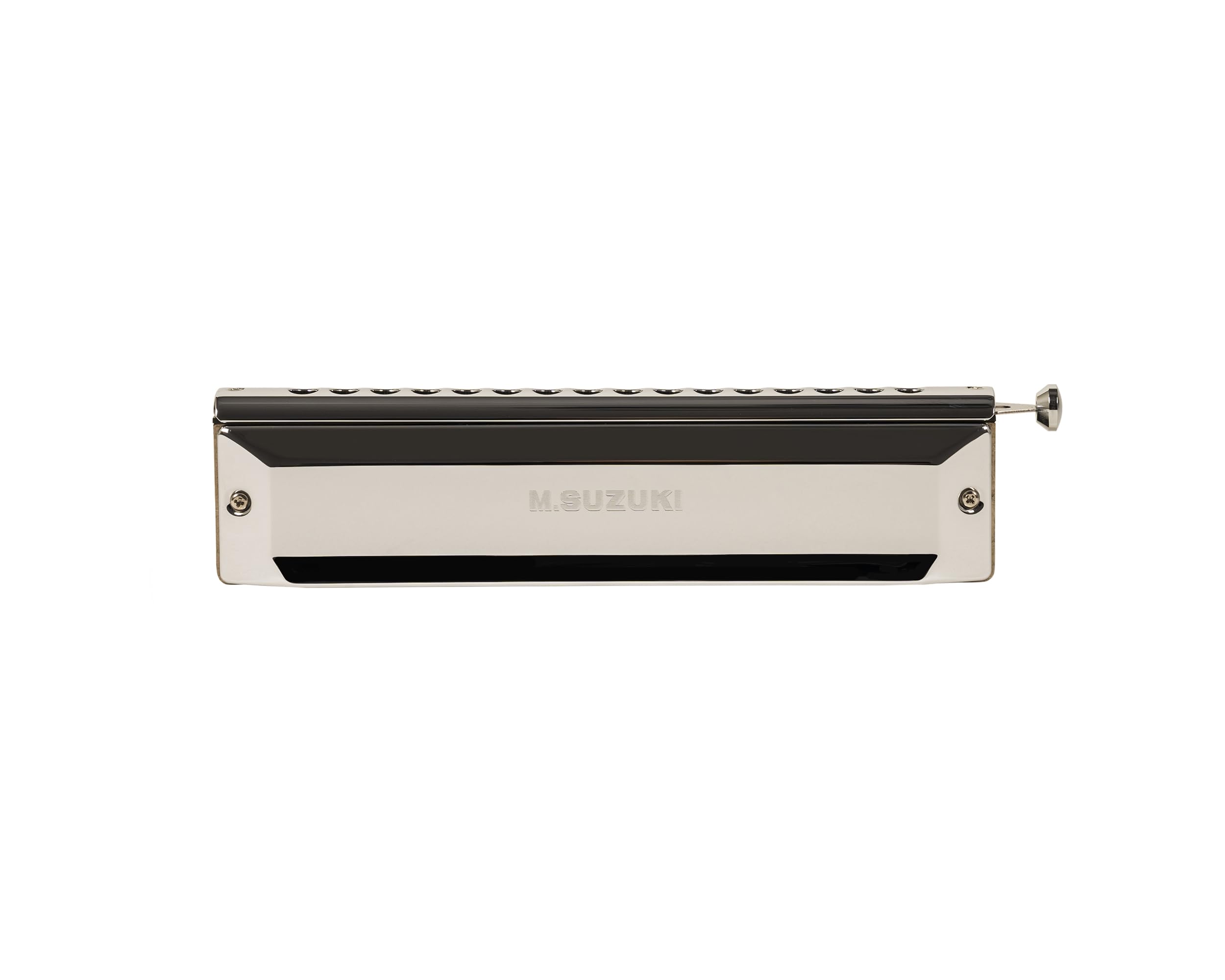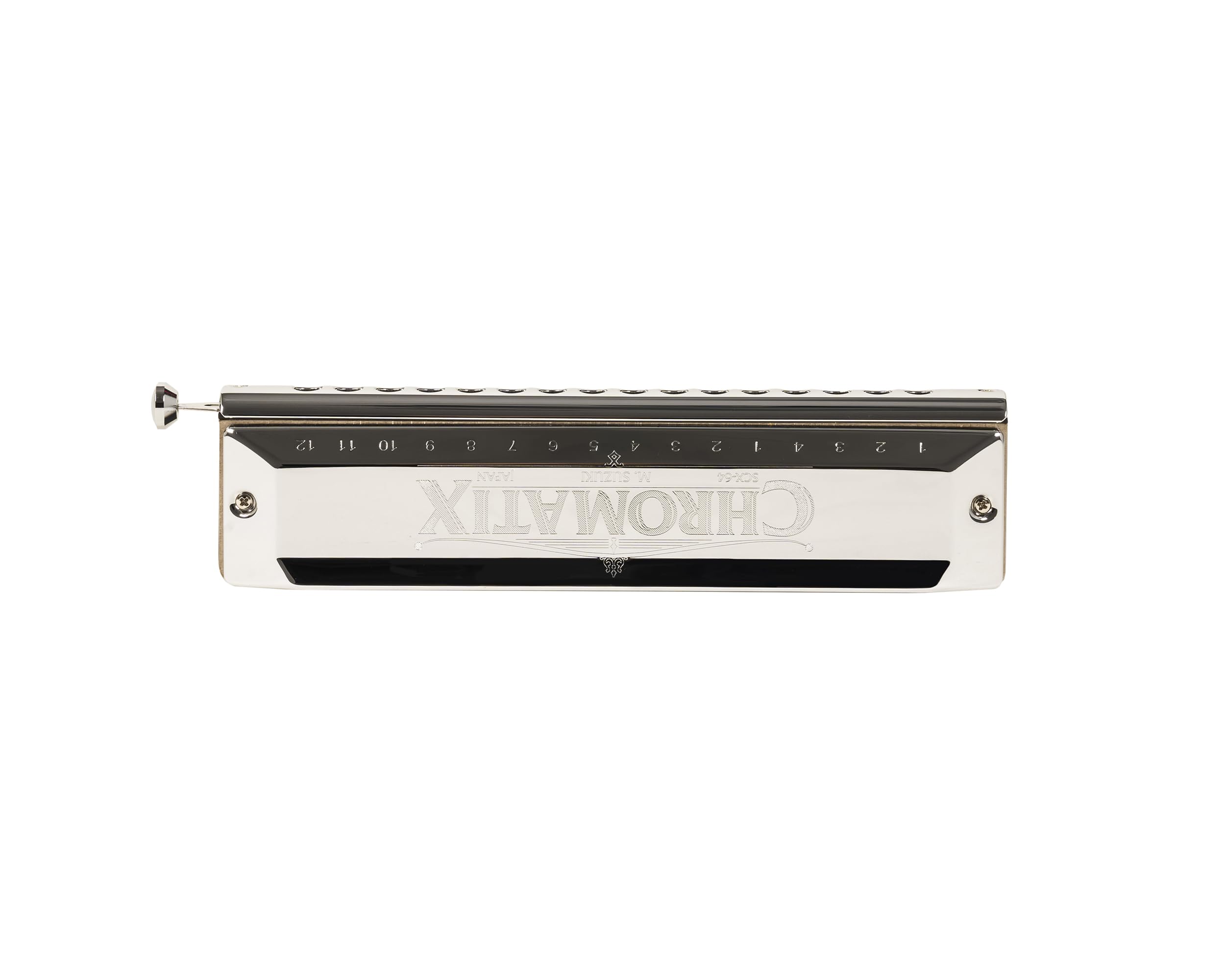










🎵 Play Your Heart Out with the Suzuki SCX-64C!
The Suzuki SCX-64C Chromatix Series Harmonica in the key of C features 64 reeds and 16 holes, designed with an ergonomic mouthpiece for comfort. Its precise slide mechanism and premium materials ensure a smooth playing experience, all while being elegantly housed in a deluxe soft-lined case.
| Item Dimensions | 12 x 12 x 2 inches |
| Item Weight | 290 Grams |
| Style | 16-Hole |
| Finish Type | Polished |
| Color | silver |
| Material | ABS Plastic |
| Instrument Key | C |
J**N
Suzuki SCX-64C Chromatix Harmonica
The Suzuki SCX-64C is just about everything the company’s blurb claims. It looks magnificent and is nice to play with its ergonomic mouthpiece and the silent, velvet-smooth slide action. Swapping from a 12 holed instrument to this 16 is fairly easy because the holes of the lowest of its four octaves are numbered 1 through 4, then the numbering starts again with another 1 at the fifth hole and continues to hole 12 (the actual sixteenth hole). This makes it two instruments in one and a new player used to a 12 hole harp can ignore the lowest octave and play the SCX-64 as a 12 hole harp. The real delight is how easily the first four holes play with their extra lower notes for tunes requiring mellow sounds below the Middle C.In the first six months of playing the SCX-64C only needed to be checked and cleaned on two occasions. Both times the slide buffers required minor attention, as well as a routine dusting inside the covers and on the reed plates. When brand new, most of the dust came from the plastic case with its faux velvet lining which shed minute fibrous particles that adhered to the lubrication of the mouthpiece slide and inside the covers. For this reason avoid using the case. Preferably, keep the harmonica in a lint-free cloth bag to protect it and for prewarming in an inside jacket pocket.The wind-saver valves often stick, especially in cold weather and the SCX-64C, like most harmonicas, needs pre-warming before playing. Gently puffing out the reeds and valves with cool dry air using a lens cleaning puffer after playing will dry out most of the condensation which causes the valves to stick. From beneath the covers, puffing dry cool air to gently lift the valves from the reed plate usually frees them while revealing any that may still be stuck. The time spent on this drying and cleaning before storing will pay dividends in the long run. Ignore the supplied cleaning cloth – it is just too small to be really useful. It is best to buy a couple of LensPen MicroKlear ™ lens cloths from any good camera store, or AMAZON. Cheap microfiber cloths tend to shed fibrous lint.On the negative side I found what looked like ominous cracks in the plastic comb. However, close scrutiny revealed these to be artifacts from the molding process where the injected resin had flowed around the molded screw hole inserts and cavities to leave hair-line trails: not surprising as the plastic comb is a complex piece of injection molding.Refitting the mouthpiece screws and bumpers is a delicate process, and because the Philips screw heads for the covers are shallower than desirable, care must be taken when matching screw-drivers to the heads. The mouthpiece screws also need to be carefully tensioned equally to allow free movement of the slide while eliminating any air leakage. The Suzuki SCX-64C is a beautiful instrument requiring painstaking care to maintain and handle.The tuning marks on the reeds are neat and the instrument is tuned to within reasonable tolerances. Any notes that fail to sound correctly are the fault of the player and not the harmonica. Learning to successfully play all the usual suspect notes requires daily, patient practice.I am in the process of searching for a second SCX-64C to have a back-up should the first require intensive servicing. In Australia these instruments are rare and seemingly impossible to acquire locally, with major re-sellers seldom able to keep stocks on hand. Even AMAZON only advertises limited quantities, and these are not always available to buyers outside the US. For the money, the SCX-64C is a Chromatic Harmonica to treasure and an instrument to satisfy most players.
I**E
Suz sucki!
Every harmonica has bad notes. Delay sound when blowing in, notes that sound like a dying moose. One of them was USED as the inside had all scratches on the reeds. For $225 I except better.
A**G
Suziki vs Saxony Chromatic, Super 64 & CX12
First of all, I have a more expensive Saxony chromatic by Seydel. I like the sound of the Suzuki better both have great comfort of the mouth area. I play Jazz on Chromatic so if you are a classical player this review is not the best. However, that being said the Suziki requires more cleaning at and you need to be careful to keep it warm so the wind savers do not stick. After a while and the slider on the Suzuki gets a bit stuck on first push when you pick it up (Ok after the first push) after not using it for a day.My Saxony has had 3 notes fail I guess from fatigue and the spring broke from fatigue so I have had reliability issues but I do practice a lot with it still it is less than 2 years old. On the plus side Seydel service is really excellent. I am not an expert but I would say that the stainless steel reads do not hold up compared to the brass in terms of fatigue. They have a different sound and the Saxony is louder. I practice on the Saxony and perform on the Suzuki. So I am not a stainless steel fan. Just got an Ozone cleaner by Ioncare, hope that helps. If I had to do it over, I probably would not have got the 4 octaves, but sometimes you run out of notes so it is good but may be hard to keep track if you are not playing by ear, that is finding where you are while playing. If you do get the Saxony, don't get the high pitch one (forget what that is called). It is too high and I was able to return it. I also own a Super Chromatic 64 which is another terrific instrument on the economic side. This is very bendable and love the sound and I would rate that highly. I also own a Honer CX12. Although this is not a favorate it has a good sound, is easy to clean and does terrific when it is cold as it has a plastic body.
A**W
Sounds good
its a pretty good instrument
B**H
Better than I had expected, even from this quality instrument
I'm not a professional player, though I have played a variety of harmonicas, primarily a Honor Echo 57/120 for several decades. I play for my own enjoyment, often for and with friends. I decided to learn to play a chromatic since tremolos don't bend and my Manji didn't have the note range I wanted. My wider-range Echo limited me to straight keyed music with no accidentals, or having to play an alternate note. Some music is just too well known to get away with that. I really like the fact that I can hit any note in a chromatic.The instrument is extremely well crafted and looks . . . well . . . beautiful. It also comes with a nice quality-looking black plastic case with velvet-like lining. It has chrome plated cover and mouth parts. The comb from the side and back are black with gold lettering on the back. The transition from covers to mouth parts is very smooth so sliding your lips is slick with no grabbiness and little perception of any edge. The key-shift action is smooth and takes little pressure. The sound is strong and not too bright -- more a mellow tone (slightly more mellow than my beloved Manji). The wide range of my 16-hole instrument allows me to easily shift the tune higher or lower for dramatic impact.After a few months of playing almost daily, I am very pleased with my selection.